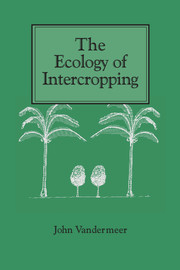Book contents
- Frontmatter
- Contents
- Preface
- 1 Introduction: intercrops and ecology
- 2 The measurement of intercrop performance
- 3 The competitive production principle
- 4 Facilitation
- 5 Mechanisms of the competitive production principle
- 6 The environments modified to produce facilitation
- 7 Special problems in intercrops involving perennials
- 8 Weeds and intercrops
- 9 Variability and intercrops
- 10 Planning intercrops – a phenomenological approach
- 11 Planning intercrops – a mechanistic approach
- 12 Critical research directions for the future
- References
- Author index
- Subject index
7 - Special problems in intercrops involving perennials
Published online by Cambridge University Press: 05 August 2012
- Frontmatter
- Contents
- Preface
- 1 Introduction: intercrops and ecology
- 2 The measurement of intercrop performance
- 3 The competitive production principle
- 4 Facilitation
- 5 Mechanisms of the competitive production principle
- 6 The environments modified to produce facilitation
- 7 Special problems in intercrops involving perennials
- 8 Weeds and intercrops
- 9 Variability and intercrops
- 10 Planning intercrops – a phenomenological approach
- 11 Planning intercrops – a mechanistic approach
- 12 Critical research directions for the future
- References
- Author index
- Subject index
Summary
Introduction
While the focus of this book is on annual crop systems, some of the more common and spectacular examples of intercropping involve perennial crops. Rappaport's classic study of the Tsembaga in New Guinea shows a complex system of succession and intercropping which includes many perennials (Rappaport, 1967). The so-called village forest-gardens in West Java exhibit similar diversity (Michon et al., 1983), as do the compound farms of Nigeria (Okigbo & Lai, 1978). To this day the Maya of Mexico maintain kitchen gardens sometimes growing over 30 species of plants, including fruit trees, bananas, and other perennials, (Alcorn, 1984). In South-East Asia the use of perennials in slash and burn agriculture is well-known (Spencer, 1966).
But it is not only in traditional peasant production that perennials are integral components. Commercial plantations involving intercrops are legion. Coffee and cacao are almost always grown with shade trees (usually a legume), implicitly an intercropping situation, although the production of the shade trees is of no consequence to the producer (Aranguren et al., 1982a, b). But many examples exist of the joint production of two perennials: cacao and coconut (Aggaoili, 1961; Garot & Subadi, 1958; Jose, 1968; Leach, 1971; Traeholt, 1962), coffee and rubber (Townsend et al., 1964), a variety of examples with African oil palm (Sparnaaij, 1957; Webster, 1969; Blencowe, 1969; Soekarno, 1961; Wood, 1966), and at least seven different perennials with coconuts (Nair, 1983).
- Type
- Chapter
- Information
- The Ecology of Intercropping , pp. 106 - 126Publisher: Cambridge University PressPrint publication year: 1989



